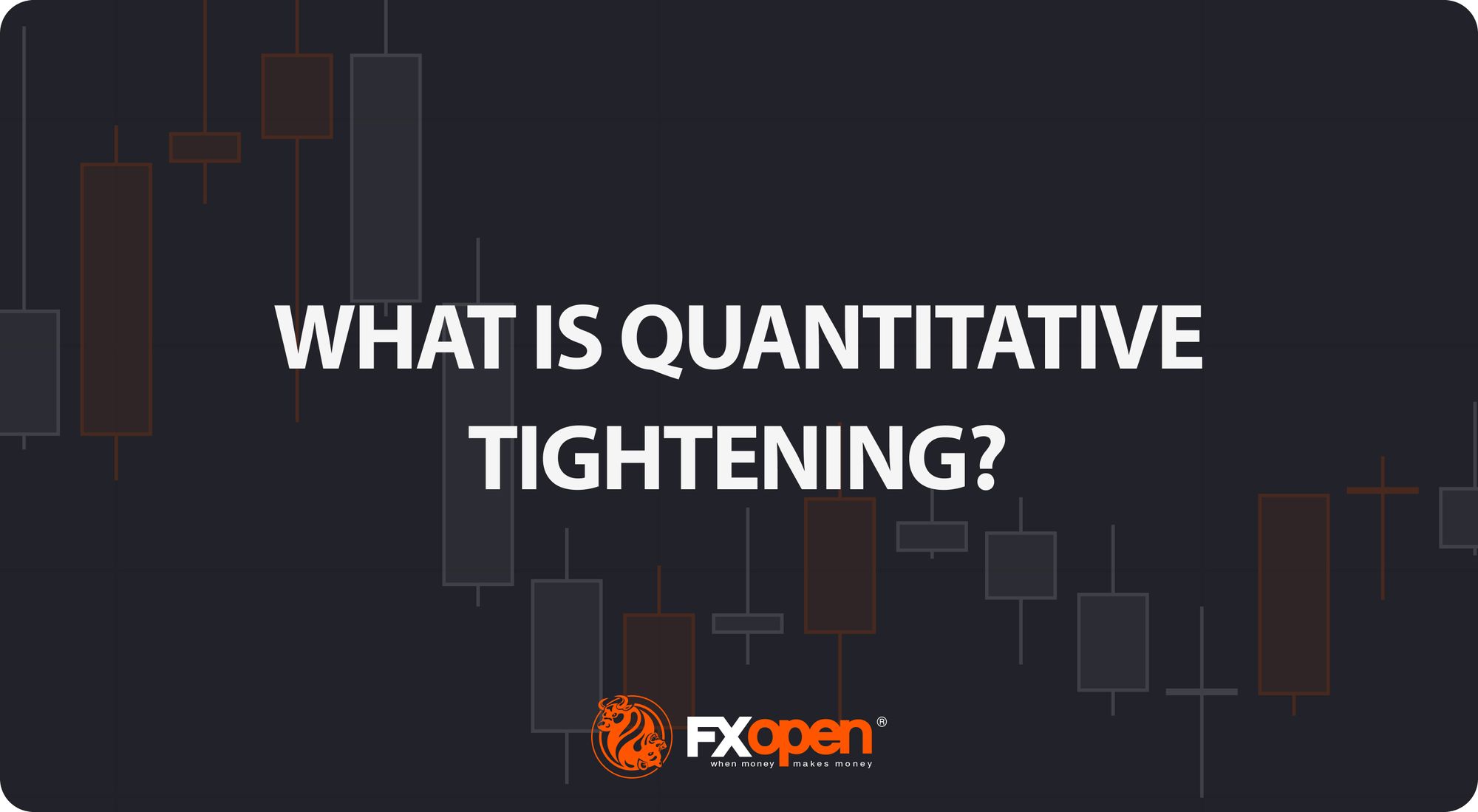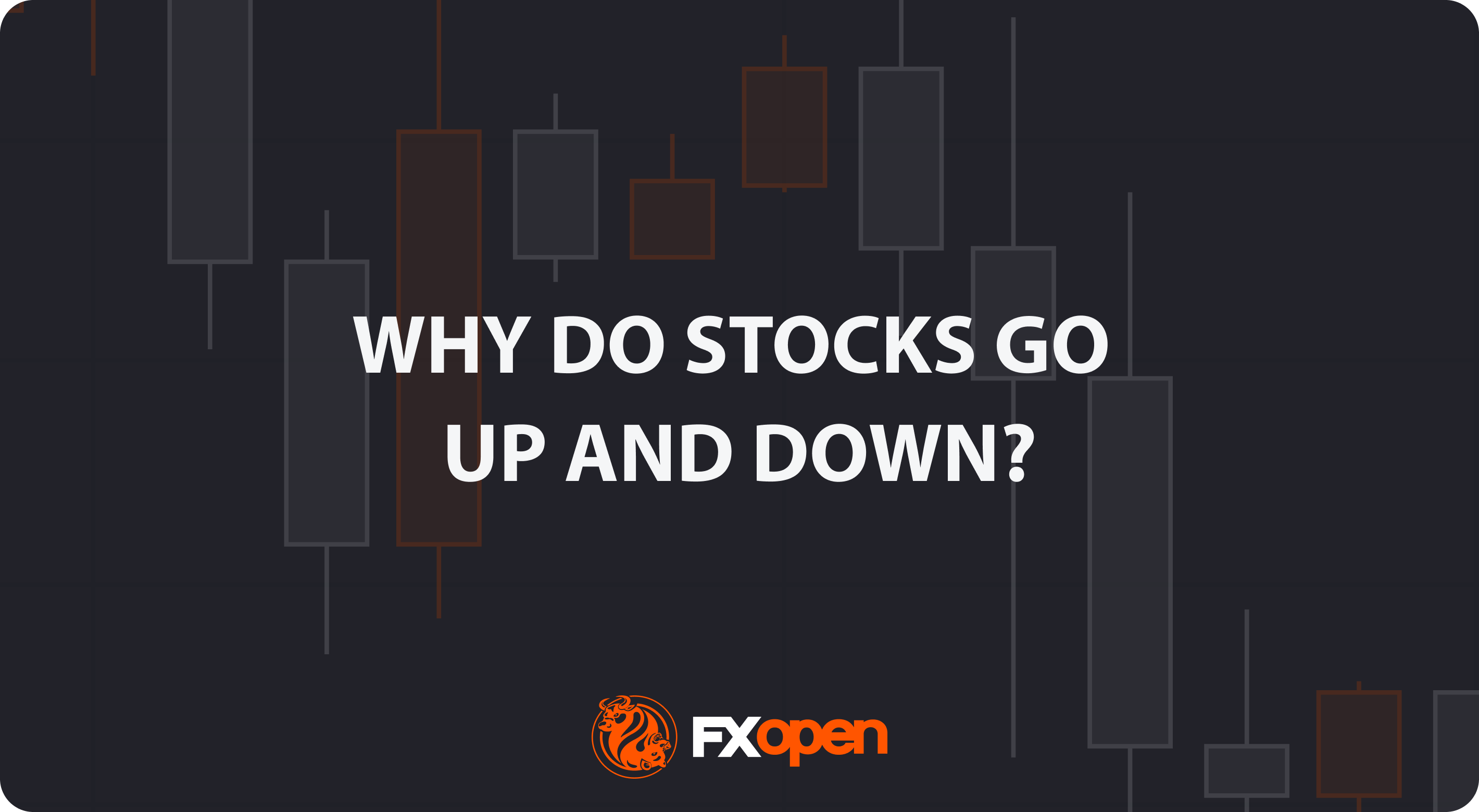FXOpen

Quantitative tightening (QT) is a critical tool central banks use to control inflation by reducing the money supply. In this article, we’ll break down how QT works, its impact on financial markets, and how it influences the broader economy. Read on to learn more about the effects of QT and how it shapes markets.
What Is Quantitative Tightening?
Quantitative tightening (QT) is a type of tightening monetary policy that central banks use to reduce the amount of money circulating in the economy.
When central banks like the USA’s Federal Reserve or European Central Bank engage in QT, they aim to tighten liquidity by reducing their balance sheets, typically by allowing bonds or other financial assets to mature without reinvestment or selling them outright. QT is a practice often used alongside hiking central bank interest rates, though not always.
The main goal of QT is to manage inflation by increasing borrowing costs and reducing demand for goods and services. By letting bonds mature or selling them, central banks effectively pull money out of circulation. This leads to fewer funds available for lending, which raises interest rates.
Higher rates make borrowing more expensive, encouraging businesses and consumers to cut back on spending, which can help cool down inflation. An example of this mechanism in action is the Fed’s QT program that began in 2022 to tackle high inflation by reducing the size of its balance sheet after years of quantitative easing.
QT is essentially the opposite of quantitative easing (QE), which is aimed at stimulating economic growth.
What Is Quantitative Easing?
QT and QE are both used to correct the economy’s course. However, while QT refers to the tightening of monetary policy, QE loosens it. During QE, central banks buy large quantities of government bonds and other assets to inject liquidity into the economy. This increases the money supply, lowers interest rates, and is intended to stimulate economic activity, particularly during downturns or recessions. QE was used extensively following the 2008 financial crisis and during the COVID-19 pandemic as a way to support economic recovery.
How Does Quantitative Tightening Work?
Quantitative tightening works by pulling liquidity out of the financial system, reducing the amount of money available for borrowing and investment. Central banks use a couple of specific methods to achieve this, which have a ripple effect on markets and the broader economy.
1. Reducing Asset Holdings
One of the most common ways central banks implement QT is by allowing bonds and other financial assets on their balance sheets to mature without reinvesting the proceeds. For example, the Federal Reserve might hold trillions in government bonds. When those bonds mature, instead of using the proceeds to buy new bonds, the Fed simply lets the money flow out of circulation. This reduces the central bank’s balance sheet and shrinks the money supply, contributing to higher borrowing costs.
2. Selling Bonds
Another method central banks use is the outright sale of government bonds or other securities. By selling assets, central banks increase the supply of bonds in the market. This can push bond prices down and drive yields higher, which makes borrowing more expensive for companies, governments, and individuals alike. Rising bond yields often lead to higher interest rates across the board, from mortgages to business loans—when there’s less money available for lending, banks raise the rates they charge for loans.
Effects of Quantitative Tightening on the Broader Economy
Quantitative tightening has significant ripple effects across the broader economy. As central banks reduce liquidity, it impacts everything from borrowing costs to consumer spending and business investment.
1. Higher Borrowing Costs
One of the most immediate effects of QT is the rise in interest rates. As central banks shrink their balance sheets, bond prices fall, pushing yields higher. This, in turn, raises the cost of borrowing for businesses and consumers. There may also be interest rate hikes alongside QT, further tightening lending conditions.
Mortgages, personal loans, and corporate debt all become more expensive, discouraging borrowing. For businesses, higher financing costs can limit expansion plans, reducing investment in growth or innovation. Households, meanwhile, face elevated mortgage rates, leading to reduced demand in housing markets and potentially lower home prices.
2. Reduced Consumer Spending
As the cost of borrowing rises, consumers have less disposable income. Higher interest rates on loans and credit cards mean households spend more on servicing debt and less on goods and services. This can slow down retail sales and reduce overall consumer demand, which is a critical driver of economic growth. Lower consumer spending typically affects sectors like retail, real estate, and manufacturing, which depend on a high volume of transactions.
3. Slower Business Growth
QT also impacts businesses by making it more expensive to access credit. Companies that rely on borrowing to finance operations, new projects, or expansions find it harder to justify taking on debt. With higher interest payments eating into profits, many businesses may delay or scale back investment plans. In addition, small and medium-sized enterprises (SMEs) that depend on bank loans for cash flow are often the hardest hit.
4. Inflation Control
While QT can slow economic activity, its primary goal is to rein in inflation. By reducing the money supply and making credit more expensive, it cools down demand. Lower consumer and business spending can reduce price pressures, helping to stabilise inflation. This was a key objective when the Federal Reserve resumed QT in 2022 to counter post-pandemic inflation.
5. Potential Economic Slowdown
However, if QT is too aggressive, it risks triggering an economic slowdown or even a recession. Tightening financial conditions leads to reduced economic growth, as seen in 2018 when markets reacted negatively to the Federal Reserve’s balance sheet reductions.
How Does Quantitative Tightening Affect Financial Markets?
Quantitative tightening can have significant effects across different financial markets. By reducing liquidity, it influences the behaviour of key assets, from bonds to equities, and can reshape market conditions in profound ways.
1. Bond Market
QT often leads to higher bond yields. When central banks like the Federal Reserve reduce their bond holdings or stop reinvesting in new ones, the supply of bonds in the market increases. As bond prices drop, yields rise to attract new buyers. This rise in yields means governments and corporations face higher borrowing costs. For instance, during the Federal Reserve’s quantitative tightening efforts in 2018, US Treasury yields rose significantly as more bonds became available in the market.
2. Stock Market
Equity markets often react negatively to QT. As liquidity tightens, the cost of borrowing rises for businesses, which can squeeze corporate profits and reduce their ability to invest or expand. Investors also tend to move away from riskier assets like stocks when bonds offer higher yields, as bonds become more attractive for their safety and improved returns. In 2018, US stocks experienced heightened volatility when the Fed’s quantitative tightening efforts combined with rate hikes led to market corrections.
3. Foreign Exchange Market
QT can also impact currency values. As central banks tighten monetary conditions and raise interest rates, their currencies often strengthen relative to others. This is because higher yields and interest rates attract foreign investment, increasing demand for the currency. For example, when the Fed began QT in 2022, the US dollar strengthened as investors sought better returns on US assets like Treasury bonds. See how the US dollar strengthening occurred for yourself in FXOpen’s free TickTrader trading platform.
4. Credit Market
QT reduces the availability of credit as banks and financial institutions face higher borrowing costs themselves. As liquidity is drained from the system, lenders tighten their credit conditions, making loans more expensive and harder to get. This can slow economic growth as businesses and consumers find it more costly to finance investments or purchases.
In effect, QT creates a tighter financial environment by reducing liquidity, pushing up borrowing costs, and shifting investor behaviour across various markets. Each asset class feels the impact in different ways, but the overall effect is a more cautious, less liquid financial system.
The Bottom Line
Quantitative tightening is a powerful tool central banks use to manage inflation by reducing liquidity and increasing interest rates. While it helps control rising prices, QT can impact borrowing costs, investment, and market stability. Understanding how these mechanisms work is crucial for informed trading.
Ready to take advantage of different market conditions? Open an FXOpen account today and start navigating more than 700 financial markets with low-cost, high-speed trading conditions, and four advanced trading platforms.
FAQ
What Is Quantitative Tightening?
The quantitative tightening definition refers to a monetary policy used by central banks to reduce liquidity in the economy. This involves decreasing the central bank’s balance sheet by selling bonds or allowing them to mature without reinvestment. QT is typically aimed at curbing inflation by raising borrowing costs and slowing economic activity.
How Does Quantitative Tightening Work?
QT works by reducing the supply of money in the financial system. Central banks achieve this by selling government bonds or letting them mature. As the bonds leave the market, interest rates rise, making borrowing more expensive for businesses and consumers.
How Does Quantitative Tightening Affect the Stock Market?
QT can negatively impact stock markets. As interest rates rise and liquidity tightens, borrowing costs for companies increase, which can hurt corporate profits. Investors may shift towards so-called safer assets like bonds, reducing demand for stocks and contributing to market volatility.
What Is the Difference Between QT and QE?
Quantitative easing (QE) increases the money supply by buying bonds, while quantitative tightening (QT) reduces liquidity by selling bonds or letting them mature. The main difference between quantitative easing vs tightening is that QE stimulates economic growth, while QT aims to control inflation.
What Does It Mean When the Fed Is Tightening?
When the Federal Reserve tightens, it implements policies to reduce money supply and raise interest rates. This helps control inflation by making borrowing more expensive and slowing economic activity.
This article represents the opinion of the Companies operating under the FXOpen brand only. It is not to be construed as an offer, solicitation, or recommendation with respect to products and services provided by the Companies operating under the FXOpen brand, nor is it to be considered financial advice.
Stay ahead of the market!
Subscribe now to our mailing list and receive the latest market news and insights delivered directly to your inbox.








